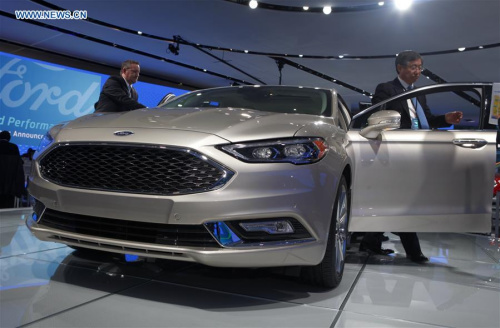
The 2017 Ford Fusion is on display at the North American International Auto Show in Detroit, the United States, on Jan. 11, 2016. (Photo: Xinhua/Li Bowen)
Driverless cars and active safety features charmed audiences at the 2016 North American International Auto Show, which kicked off in Detroit Monday.
The clear winners of the show were Volvo and Ford, with both companies stressing different advances in both active safety features and driverless systems. The U.S. Army also brought their own driverless truck, but the technology in it is not expected to be available to consumers.
Geely-owned Volvo Car Company placed an emphasis on safety for its automated functions, setting a goal of zero deaths or serious injuries in a Volvo car by the year 2020. Erik Coelingh, senior technical leader for active safety and autonomous vehicles at the Volvo Cars Group, told Xinhua that they are not only improving passive safety features to protect occupants in case of a crash, but also targeting specific types of preventable accidents through automated driving.
"Typical scenarios that we will address are run-off-road accidents, intersection accidents, but also accidents with animals, especially large animals," he said.
Volvo's goal with off-road accidents is to prevent the car from falling off the road in the first place, Coelingh told Xinhua. "The best thing is to really keep the car on the road, so if we detect with our cameras and radars that the car is about to leave the road, you will get a small steering correction that helps keep the car on the road, and we can even slow down the car to mitigate this phenomenon."
These two features are included in the company's latest model sedan, the Volvo S90, which has a 2.0 inline-four engine with either a turbocharger, a supercharger, or a hybrid engine, depending on the model. A plug-in S90 is also available. The same systems that power safety in the car also improve ease of use: The car can accelerate, brake, and steer automatically, something which Coelingh believes will prevent accidents.
On the other side of the show floor, U.S. automaker Ford is looking at the long-term possibilities of driverless vehicles. During an extravagant press conference in the Joe Louis Arena with loudspeakers and a massive video wall, Ford CEO Mark Fields told reporters that he intended to "disrupt" the auto industry with a self-driving car before the tech industry could.
The execution of the strategy behind that statement is evident. James McBride, technical leader for autonomous vehicles at Ford Motor Company, told Xinhua that he was working on technology that would create a backbone for drive automation-based products and services.
"Once you start to think about the potential uses of autonomy, they span quite a spectrum," he said. "You can have everything from easing urban congestion to improving mobility, to helping the young and the elderly, who aren't as talented drivers. You can platoon cars for better fuel economy," he said.
The technology that Ford is working on is likely to have a specific benefit for Chinese drivers, as the number of China's car buyers continues to grow. "China is one of these countries that has a vast growing number of megacities and the congestion there is obviously really bad, and one of the potential applications of economy is the ability to improve mobility in these kinds of environments," said McBride.
The U.S. Army was also present with two driverless trucks, running the Army's Autonomous Mobility Applique System mounted on a military tractor-trailer.
The Army's goal is to add driver assistance to a truck, or create a driverless convoy option for the Army. While they do intend to partner with automotive companies, none of the technology they have developed is currently available in consumer cars.
The North American International Auto Show, taking up more than 722,500 square feet in the Cobo Center, will last from Jan. 11 to 24. It features a total of 45 vehicle debuts with more than 500 vehicles on display. U.S. President Barack Obama is expected to visit the show on Jan. 20th.


















































